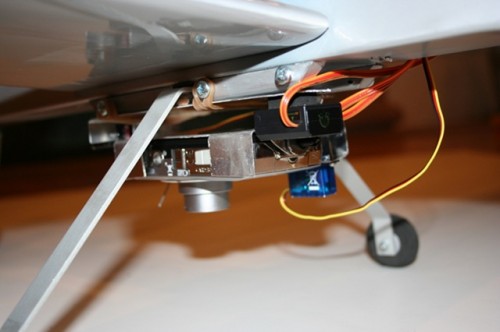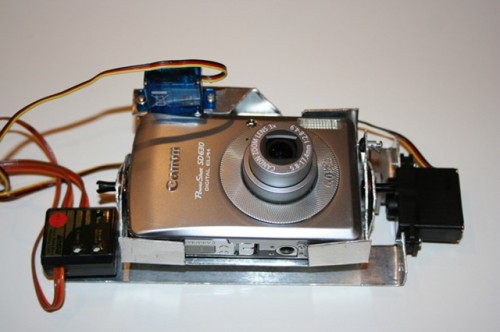Chris Anderson was lucky enough to visit the Google campus and took some arial pictures with a digital camera mounted to an RC plane. To enhance the picture taking capability of the rig he decided to make a gyro stabilized system to mount the camera onto.
Video after the jump.
“The secret ingredient is an off-the-shelf “heading hold” gyro made for a R/C helicopter. These can be found for as little as $40, but after some experimentation I found that you need one that has special circuitry to resist gyro drift (there are several of them here, ranging from $74 to $199. I’m going to test several of them to find the cheapest one that works; right now I’m using one I had that doesn’t have drift cancellation and it won’t work for anything but benchtop tests)
For the tilting camera mount and base, you’ll need a sheet of relatively thin aluminum. I used a .032 X 6 X 12 sheet. Anything thicker won’t bend properly. I cut out several prototypes from cardboard before committing to metal (and still had to do the metal twice, when the first sheet proved to be too thick). I’ve made a pdf that you can print out and use as a template (when printing, set “page scaling” to “none” so it prints full-size). This one was designed for a Canon Digital Elph camera (all the recent vintages, from the 500 to 900 series, are about the same size); if you’re using a different camera you may need to modify some dimensions slightly to fit.”

|
|


Permalink
As i see the camera is shakeing each time the stabilization, if u make moveingpicture it can be bothersome. I heard a way to stabilize such cameras: u attach a wheight to the camera with a bar, towards the ground. Its mass will compensate the pitch, so the camera will look almost exactly towards the ground. But hanging weights on the plane is a bad thing.
I hope someone can understand what am i talking about, because of my bad english.
Permalink
Permalink
I’ve always wanted an rc plane.
Permalink
Permalink
Permalink
“As i see the camera is shakeing each time the stabilization, if u make moveingpicture it can be bothersome. ”
Exactly, the servos are replacing the low speed rolls with a high speed judder, exactly what I was expecting. Seems not very useful.
Permalink
Permalink
All you need for smoothing out the gyro’s correction are quality fast, digital servos. The new Hitec HS-5065’s would be perfect. The problem with using a Gyro isn’t the Gyro, which in this case looks like a Futaba GY-401 or GY-240, but the servos used in conjunction with the gyro(s). HS-55’s, what I am presuming these blue servos are, are not fast enough or accurate enough for smooth gyro response. The speed and precision of the servos has to be at par with the speed and accuracy of the gyro itself.
Permalink
interesting mount camera
could we buy from you?
how much it cost? thanks
Permalink